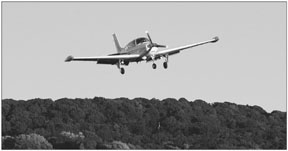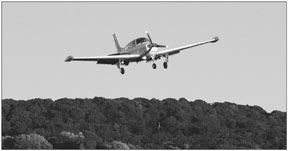
by Jeff Pardo
With the possible exception of an approaching sharks gaping maw, there isnt much else that most earthlings would find as viscerally terrifying as being tossed headlong from a cliff into thin air, or taking a leap off the ledge of a high-rise building.
When it comes to the flying fraternity, however, many of us might claim that falling isnt among our primal fears (though more than a few would be lying). Be that as it may, as pilots we need altitude.
From almost the first day of ground school, were taught that altitude is our friend. Well, we need it most of the time, but then again there are other times when we might have more than we need. Who among us hasnt ever been too high on final approach, possibly because we misjudged our perspective to the runway? The record of runway overrun incidents and accidents argues that there are quite a few of us in this category. Then again, you might make a conscious decision to stay high if youre having engine trouble and you want ample amounts of altitude until youre assured of reaching some nice smooth pavement. And who hasnt faced even the meekest crosswind, combined perhaps with a runway only slightly wider than the main gear?
One solution for regaining a figurative foothold in these slippery situations-yes, I realize Im approaching unendurably vaudevillian levels of insinuation here-is the slip.
What And When?
So just what is a slip? One operational definition says that its when the rate of turn is too low for the angle of bank. Thats usually the first kind of slip to which were introduced. When this happens, you slip downward in the direction of turn. That can be helpful when you intend to descend, as well as turn. Mostly, pilots make use of a more linear application of this mismatch, when they perform forward slips.
Basically, the slip is a maneuver where you deliberately (hopefully, not unintentionally) present more of one side of the fuselage than the other into the wind: flying sideways if youll permit the exaggeration. My own personal suggestion for how best to both remember and initiate a slip is to start by lowering a wing in the desired direction, using the ailerons in the usual way, and then apply opposite rudder. The worlds best and most succinct summation is right here in these three words: kick top rudder.
Two Kinds
As most of us refer to slips (aside from the slipping turn), we tend to think of two different kinds. There is the forward slip, and then we have the side slip. As far as the airplane is concerned, theres almost no difference between the two; the airplane cannot tell whether its in a forward or a side slip, because the necessary motions for performing each one are the same.There is a difference, of course.
In a forward slip, the airplanes longitudinal axis isnt aligned with the runway (the actual runway or the extended runway centerline), and you control your rate of descent by adjusting your angle of bank (rather than in the normal pointy end forward mode of flight, in which the more primary control surface for adjusting the descent rate would of course be your elevator, instead of your ailerons).
It is also one of the best ways to increase your rate of descent without building up too much airspeed. In a side slip, one will usually want to slip wing-low into the prevailing crosswind, with the airplanes longitudinal axis basically aligned with the runway centerline, adjusting your angle of bank to control drift to keep yourself over that runway centerline (actual or extended).
In a sideslip, the same thing is happening although perhaps to a lesser extent, as the forward slip component during a sideslip is just aligned with whatever crosswind you are fighting, rather than the runway.
Why Slip?
Speaking for myself, when I got my first look at a slip from inside the cockpit, it was quite exhilarating, but also somewhat disorienting. I can still remember the amazing sensation of looking not too far off from directly out my side window at the rapidly approaching runway when my instructor, Jim Beams, first demonstrated it to me in all its glory. Because of the amazing rudder authority that old J-3 Cub had, it really did seem like I was looking out the side window at the runway.
If ever you need to increase your rate of descent without affecting your airspeed much, the forward slip is the way. Theres a significant cosine loss of indicated airspeed because the relative wind and the pitot tube are no longer parallel and the ram air no longer rushes straight into it. However, total airspeed doesnt significantly increase, even with a cosine gain from the steeper glide path. But the take-away point here is to be leery of placing much faith in the airspeed indicator during a forward slip.
Of course, the old 1947-vintage J-3 Cub that Jim and I used to fly at that grass strip near Baltimore didnt have flaps. And thats probably the origin of this maneuver from the days of yore. Back then, who needed `em? A flap was a term used to refer to the buzz and commotion after somebodys faux pas, or what a flag does in a stiff breeze, and most airplanes of the day could already land short enough, thank you very much.
Whats In A Name?
One could get into a semantic argument as to why the names of these two types of slips arent the other way around, and can conceivably be so tricky for new students to remember which is which (i.e., why call it a forward slip when one isnt pointed forward and why say side slip when you are?).
Despite the fact that this is aviation, and not philosophy, Ill attempt to stake some high ground here. Just think of the direction in which one is slipping (not pointing), and that should resolve the issue (maybe). In general, though, the forward slip is used to lose altitude, while the side slip is used for crosswind landings. Yes, its cross-controlled flight, and yes, this is exactly what can precede the deadly spin. Your indicated airspeed can be unreliable, and while your longitudinal axis is pointing somewhere else, you have to remember to keep your ground track pointed where you really want to get by using the rudder pedals. And you have to remember to keep the nose down so that you stay safely above a stall. (In fact, youll often find yourself having to exert forward pressure to keep the nose down against the tendency of the aircraft to nose up from holding in that top rudder.)
In slips, attitude is the key thing, not airspeed. You generally use about the same amount of pitch as in a normal glide. As you increase the bank angle in a slip, you will need to apply more opposite rudder in order to maintain directional control (e.g., not turn, unless that is you want to). At some point, when the rudder pedals hit the stops, you will have run out of rudder authority. If you need a still greater rate of descent, you have the option of lowering the nose further, which increases airspeed, which in turn makes the rudder more effective, and which allows a still steeper slip.
As I said, there are some times when it might come in handy (and it can show up on the check ride). Besides adding to your ability to lose altitude when flaps arent enough (assuming the airplane is not placarded against doing so-see the sidebar on this page), the slip has other uses, too.Remember it if something forward of your firewall ever puts you in the skywriting business (or heaven forbid, if you ever have an engine fire), and you need to keep smoke (or flames) away from the cockpit. Dont forget it if youre ever faced with a forced landing, and you need to get shoehorned into someplace really tight (and youre not exactly worried about being able to fly it out again). For that matter, you can use a slip to help close a door that popped open in flight (but need I remind you that this is only if youre at a safe altitude, and theres not much else going on). And I rather doubt that Id need to convince you of its utility during your next crosswind landing.
When Not To Slip
Then again, there are times when you might think twice before performing a slip. A slip is not an excuse to salvage a poorly planned approach. Also, even if youre not doing it because you have to (whether that reason has to do with short stature, or…sudden ice formation on the windshield…) beware of slips when the winds are gusty, or the geography youre over-flying might generate mechanical turbulence. Another caution concerns the few airplanes placarded with respect to slips.
Still another is when youre low on fuel. Im sure you can guess why: if the tank is already almost empty, the fuel line coming from the tank could just start sucking air instead of fuel. This isnt something youre likely to find a quantitative look-up table for, either. (Lets see, now…I have 12 gallons left, so the chart says I can slip with up to a 20-degree bank…) The very situation in which youre likely to do this, i.e., close to the ground near the end of a flight, could conceivably make its practicality a bit academic, but most of us dont flight plan our fuel with brinksmanship in mind.
Another actually quite realistic instance is when you have a passenger unaccustomed to this sort of perspective change on short (or any) notice.Finally, speaking about the end of a flight, pilots not yet well acquainted with forward slips should recover to a slightly more normal attitude (even if that is a sideslip) no lower than 200 feet above the runway. An airline pilot friend even once admitted that although this tends to be a procedure kept close to the chest, even airliners use the forward slip from time to time during normal operations. Whenever they find themselves a tad high on the glide slope (even after they have deployed the flaps, that is) theyll dip a wing a very few nearly-imperceptible degrees, and even savvy cabin attendants are none the wiser.
Conclusion
Since I love trivia, Ill close by tossing this one out: the slip isnt the only way to get down quicker, without going faster; one name for that maneuver is the falling leaf. In it, you enter a power-off stall, using alternating left and right rudder to the point where there was a small heading change-as well as the theoretical incipient spin, truth be told.(Theres a bit of knuckle-biting involved, and I mention it for academic reasons alone. Unless youre pulling hazardous duty pay, leave this one for when the houses are still really small.) The same thing applies to slips as with stalls, steep turns, or anything else we take pride in doing well. While slips certainly arent as hazardous as solo hood work, like anything else we do in three dimensions it behooves us to understand them as completely as possible. Class dismissed.
Also With This Article
“The Mother Of All Slips?”
“Slips And Your POH”
“Slip Aerodynamics”
-Jeff Pardo is a freelance writer and editor who holds a Commercial certificate for airplanes, helicopters and sailplanes.




